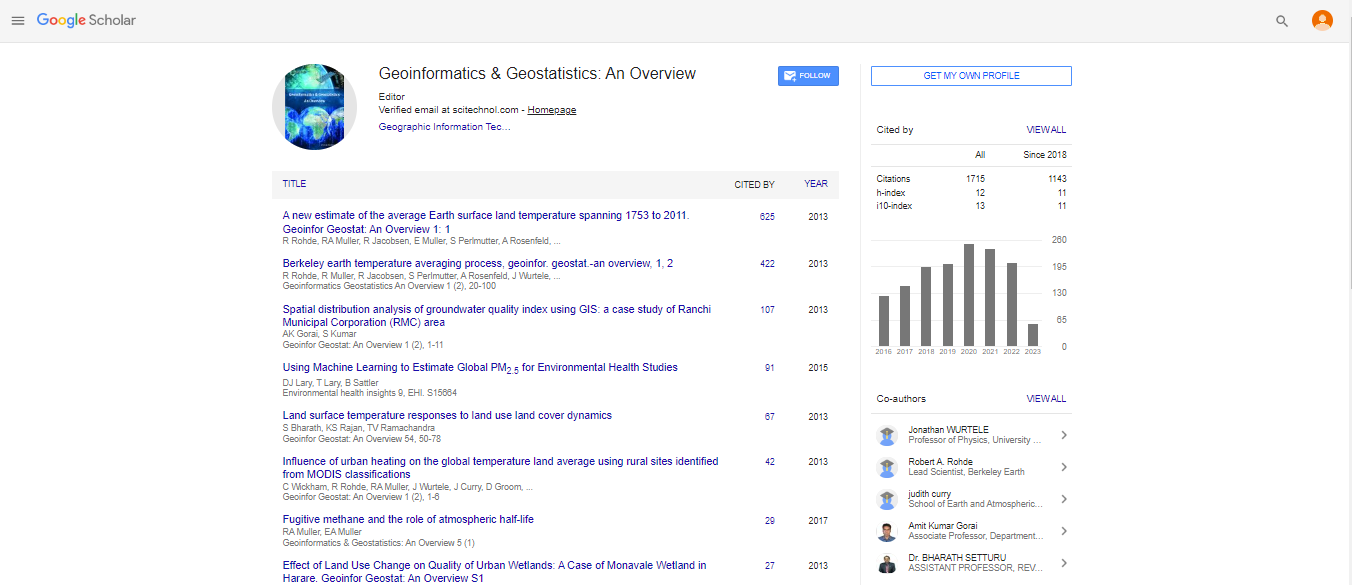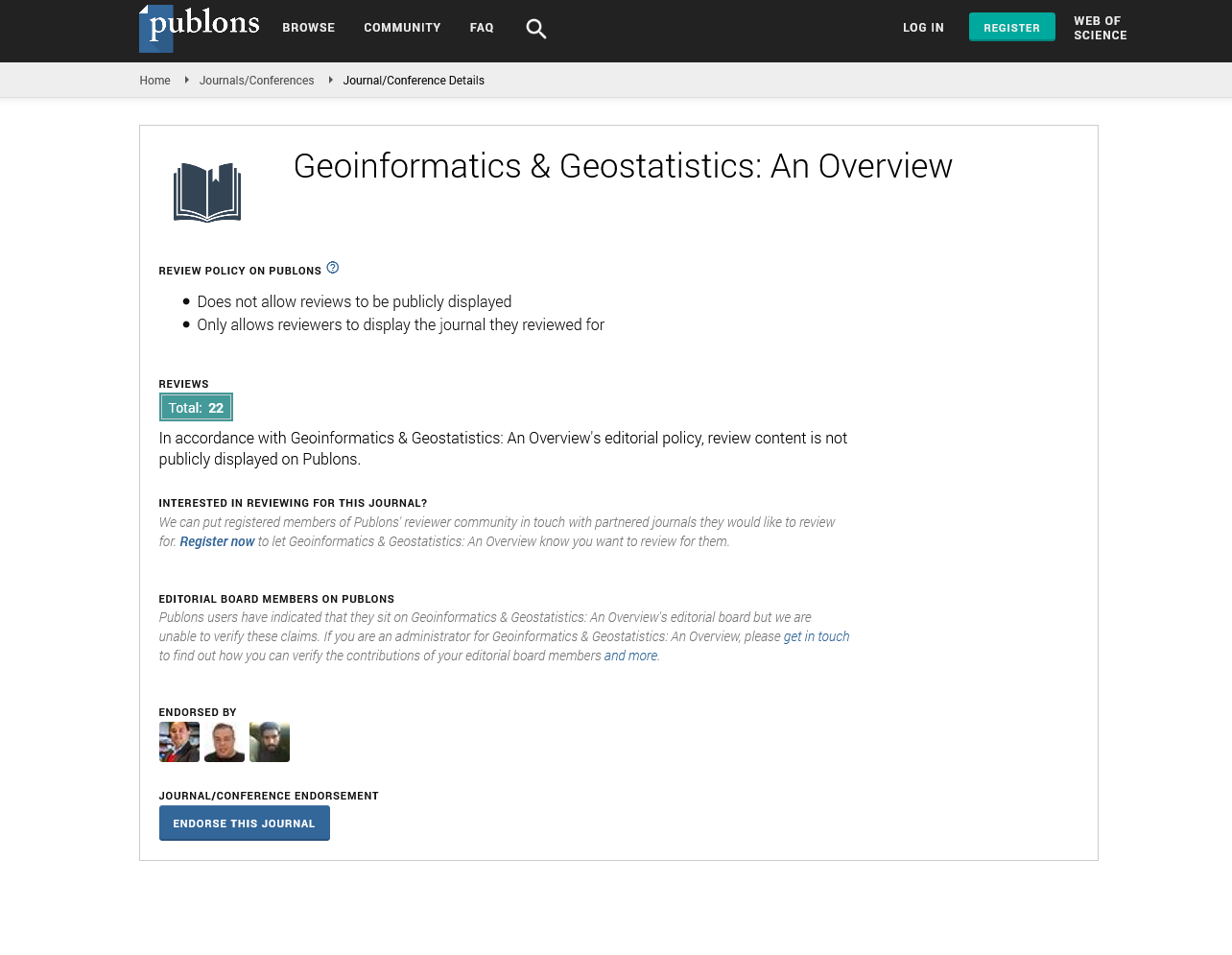Short Communication, Geoinfor Geostat An Overview Vol: 13 Issue: 3
A Remote Sensing Framework for Assessing Wildfire Chronosequence and Ecosystem Recovery.
Najera De Ferrari*, Duarte E, Smith Ramirez C, Merino C, Rubilar R, Pereira P, Jofre I and Matus F
Geomicrobiology Laboratory, Faculty of Engineering and Sciences, Department of Chemical Sciences and Natural Resources, University of La Frontera, Chile
*Corresponding Author: Nájera De Ferrari
Geomicrobiology Laboratory, Faculty of Engineering and Sciences, Department of Chemical Sciences and Natural Resources, University of La Frontera, Chile
E-mail: francisco.najera@ufrontera.cl
Received date: 15 May, 2025 Manuscript No. GIGS-25-165555; Editor assigned date: 19 May, 2025, PreQC No. GIGS-25-165555 (PQ); Reviewed date: 02 June, 2025, QC No. GIGS-25-165555; Revised date: 09 June, 2025, Manuscript No. GIGS-25-165555 (R); Published date: 16 June, 2025, DOI: 10 .4172/2327-4581.1000438.
Citation: Nájera De Ferrari, Duarte E, Smith Ramirez C, Rendon Funes A, Gonzalez NS, Gonzalez VS and Matus F (2025) A Remote Sensing Framework for Assessing Wildfire Chronosequence and Ecosystem Recovery.. Geoinfor Geostat: An Overview 13:3.
Introduction
Wildfires are transformative disturbances that reshape ecosystems, affecting vegetation, soil properties, and biodiversity. Understanding post-fire recovery is critical for managing resilient landscapes, especially as climate change intensifies fire frequency and severity. Our research presents a comprehensive methodological framework to evaluate wildfire impacts and recovery of soils and vegetation over a 23-year chronosequence using remote sensing validated in the field [1]. This study’s innovative integration of geospatial technologies with ecological fieldwork contributes to wildfire science and has implications for forest management.
The research strength lies in its fusion of remote sensing analyses with ground-truth data to assess burn severity and ecosystem recovery. By leveraging the Google Earth Engine (GEE) platform, it processed multi-temporal Landsat imagery (1985–2024) to calculate spectral indices such as the Normalized Difference Vegetation Index (NDVI), Normalized Burn Ratio (NBR), and differenced NBR (dNBR). These indices were critical for classifying burn severity and tracking vegetation recovery [2]. The LandTrendr algorithm further enabled temporal segmentation of pixel-level changes, distinguishing fire events from other disturbances (e.g., logging or cloud interference) [3,4]. On top of that, a field validation was performed involving soil sampling (0–5 cm depth) and vegetation surveys across 40 sites in Chile’s La Araucanía region, focusing on volcanic ash-derived soils (Andisols). Parameters such as Soil Organic Carbon (SOC), bulk density, hydrophobicity, and litter depth were measured to corroborate remote sensing findings. This dual approach combining satellite-derived trends with physicochemical soil data ensured robustness in identifying recovery patterns.
Key findings
The key finding of this study encompasses the burn severity and recovery dynamics of natural and managed ecosystems: High-severity burns exhibited significant reductions in NDVI and NBR immediately post-fire, with gradual recovery over decades. Native forests showed slower initial recovery than Pinus radiata plantations but achieved comparable SOC levels (~ 25%) after 23 years. The dNBR effectively distinguished severity levels, aligning with the USGS classification. Negative dNBR values post-fire indicated vegetation regrowth, consistent with field observations of litter accumulation and canopy closure.
Soil recovery patterns: Within two decades, SOC and bulk density in burned sites converged toward unburned reference values. Hydrophobicity, a fire-induced soil water repellency marker, declined from extreme (index 5) to moderate levels (index 2–3) within 6–12 years. Native forests prioritized soil carbon stabilization, whereas plantations favored rapid biomass recovery, highlighting trade-offs between resilience strategies.
Temporal and spatial constraints: Pre-2000 data limitations (sparse Landsat coverage) reduced chronosequence resolution for older fires. Cloud cover and topographic shadows further complicated image selection, necessitating manual validation.
Strengths and advancements: Cloud-based platforms democratize large-scale geospatial analyses, enabling researchers to process decades of imagery without high computational costs [5]. LandTrendr’s temporal segmentation enhances accuracy in distinguishing fire events from other disturbances. Combining NDVI (sensitive to green biomass) with NBR/dNBR (responsive to soil moisture and burn scarring) provides a holistic view of ecosystem changes. And the focus on Andisols, prevalent in fire-prone regions like Chile, has unique properties (e.g., high organic matter retention). The study’s emphasis on these soils fills a gap in post-fire soil recovery.
Limitations include sample size constraints (40 sites), sensor resolution trade-offs, and reliance on historical fire records prone to underreporting [6]. Nevertheless, the study’s hybrid approach combining cloud-based analytics with ground-truthing sets a precedent for interdisciplinary wildfire research. Future directions could integrate microbial community analyses or LiDAR-derived canopy metrics to refine recovery assessments, particularly in heterogeneous landscapes.
This methodology offers actionable insights for land managers:
Prioritizing rehabilitation: Identifying high-severity zones enables targeted reforestation and erosion control.
Adaptive management: Monitoring dNBR trends helps assess intervention efficacy and policy frameworks. It is suitable for local or national fire management strategies by mapping vulnerable areas and informing post-fire land-use policies [7]. Future research could integrate different scales of analyses, such as soil microbial analyses or image analyses, with LiDAR canopy data to refine recovery assessments.
Conclusion
Remote sensing allowed the analysis of large areas for extended periods. The burn scars assessment improved its accuracy with more satellite images available. Possible mistaken areas were related to fast changes in land use and image misinterpretation. Those were corrected with in situ visits and local knowledge of past events. Second, wildfires are unpredictable, and over time, the severity and affected areas are not homogeneous; to solve this issue, adjacent years were clustered to find sites, and soil and vegetational analyses were performed. With this approach, of the 40 chronosequence sites, 80% were accurately selected using the computing Platform and the LandTrendr analyses of the forest recovery.
Our research advances wildfire science by bridging remote sensing scalability with ecological specificity. The chronosequence framework not only elucidates post-fire recovery mechanisms but also provides a replicable model for regions grappling with escalating wildfire risks. As fire activity exacerbates, these methodologies will be indispensable for fostering ecosystem resilience and sustainable land management.
References
- Duarte E, Zagal E, Barrera JA, Dube F, Casco F, et al (2022) Digital mapping of soil organic carbon stocks in the forest lands of Dominican Republic. Eur J Remote Sens 55(1):213-31.
- Keeley JE (2009) Fire intensity, fire severity and burn severity: A brief review and suggested usage. Int J Wildland Fire 18(1), 116-126.
- Kennedy RE, Yang Z, Cohen WB (2010) Detecting trends in forest disturbance and recovery using yearly Landsat time series: 1. LandTrendr- Temporal segmentation algorithms. Remote Sensing Environ 114(12): 2897-2910.
- Kennedy RE, Yang Z, Gorelick N, Braaten J, Cavalcante L, et al (2018) Implementation of the LandTrendr algorithm on google earth engine. Remote Sensing 10(5):691.
- Gorelick N, Hancher M, Dixon M, Ilyushchenko S, Thau D, et al (2017) Google Earth Engine: Planetary-scale geospatial analysis for everyone. Remote Sensing Environ 202:18-27.
- Miranda, A., et al. (2022). The Landscape Fire Scars Database: Mapping historical burned area and fire severity in Chile. Earth Syst Sci Data 4(8):3599–3613.
- De Ferrari FN, Duarte E, Smith RC, Rendon FA, Gonzalez VS, et al (2024) Multi-temporal assessment of a wildfire chronosequence by remote sensing. MethodsX. 13:103011.
 Spanish
Spanish  Chinese
Chinese  Russian
Russian  German
German  French
French  Japanese
Japanese  Portuguese
Portuguese  Hindi
Hindi 
